Heated sheriff election tops year in local news
Published 10:54 am Wednesday, December 31, 2014
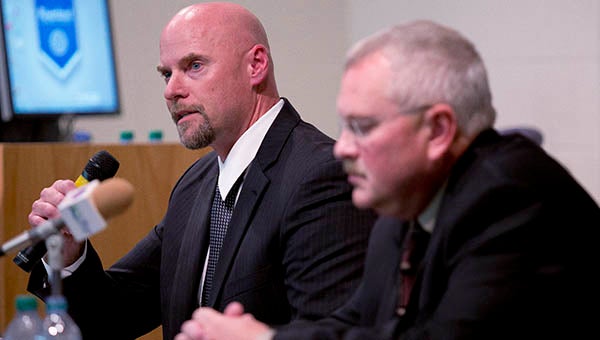
Deputy Kurt Freitag answers a question during the debate for the Freeborn County sheriff election Oct. 27 at Riverland Community College. He went on to win a four-year term, knocking off incumbent Bob Kindler. – Colleen Harrison/Albert Lea Tribune
Year in Review 2014
By Albert Lea Tribune
Determining the top story of the year is rather easy some years for the Tribune news staff. Situations like tornados or a downtown reconstruction make it simple.
Not so this year. The reporters, editor and publisher hashed it out in mid-December.
The editor, Tim Engstrom, felt the bitter winter — the harshest in 35 years — was the top story, considering the sheer amount of ink spent and the number of people it affected. Some of the reporters felt the school calendar or the mudslinging sheriff race was a bigger deal, holding more sheer news value. Publisher Crystal Miller saw both sides, but felt the calendar and sheriff race had more appeal.
Engstrom acquiesced, and everyone agreed the winter was third place. But which was a bigger deal, the sheriff race or the calendar? After everyone raised points about both, photographer Colleen Harrison pushed the needle toward the sheriff race with a comment about how no one knew on Election Day which candidate would win after all the allegations had been made, so the result of knocking off the incumbent gave it greater news value. The rejection of the calendar plan, in contrast, leaves no change.
Reporters Hannah Dillon and Sarah Stultz agreed, saying the calendar issue grew as the year passed, but the sheriff’s race was contentious from the start.
In the end, here is how the news of 2014 lined up:
1. Sheriff race gets ugly, and Bennett knocks off Savick

Deputy Kurt Freitag celebrates Election Night at Wedgewood Cove Golf Club after winning the Freeborn County sheriff race against incumbent Bob Kindler. – Colleen Harrison/Albert Lea Tribune
There had been some nasty sheriff races before, but this one took the cake. Residents of Freeborn County widely agreed during and after the campaign season that the race they witnessed between incumbent Bob Kindler and challenger Kurt Freitag was the ugliest in memory.
It even began before the primary election, when deputy Dale Glazier was in the race. Glazier was placed on administrative leave on May 30 — the same day he filed his campaign papers — over alleged misconduct. He returned to work in late July after the Olmsted County Attorney’s Office cleared him of allegations.
He had been accused of intimidating three boys in the locker room at Southwest Middle School after they reportedly assaulted his great-nephew, of whom who he has custody. The investigation found he was off duty and supervised by a coach while speaking with the boys about bullying and sportsmanship. Glazier maintained the suspension and initiating an investigation were politically motivated actions.
Freitag won the primary after looking sharp in a debate at Albert Lea City Hall, with Kindler taking second, knocking Glazier out of the race.
Then the real dirty stuff began to happen. The list of sketchy incidents was long, with objects in the rearview mirror still foggy as 2014 comes to a close:
• Who fed a Mason City TV station a questionable story about Freitag, a patrol deputy, campaigning on duty when all he really did was kindly respond to a question, the same as anyone would?
• Who was responsible for starting or escalating a confrontation between Freitag and homeowner Jim Bronson over a sign he defaced on his lawn? Did Bronson seek out Freitag? Did Freitag knock Bronson down? Why didn’t Freitag just call the cops? No one’s stories aligned. In the end, everyone learned that state law says signs belong to the campaign, not the property owner, and it is a misdemeanor to deface them.
• Who opened up a deputy’s computer and improperly viewed and disseminated investigative files? No one, it turned out. An information-technology investigation found the allegation to be unsubstantiated.
• Who created a website that maligned Freitag in ways that might be considered criminal defamation had state law regarding campaign speech not been struck down in the courts, leaving a Wild West situation? The website said unprintable things and attacked Freitag on a personal level.
• Everyone was scratching their heads over a one-sided segment from an Austin TV station.
• What role did deputy Marc Johnson play in various incidents? There was a stream of debate over a promotion to detective he received over Freitag, and the adversarial relationship between the two men played out in public.
• Let’s not forget the Hollandale farmer who was concerned about the Freeborn County Sheriff’s Office not solving a crime of equipment theft, even when the farmer located the stolen equipment across the Iowa border. An investigation found that, without identifying marks, there wasn’t enough evidence to prove theft.
On Election Day, Freitag garnered 54 percent of the vote and proved victorious over Kindler. The deputy had loyal supporters, and he won the middle while Kindler was slow to respond to concerns about his department. For example, many people remarked that the libelous website did more harm to Kindler than to hurt Freitag.
House District 27A voted out its incumbent again. This time, first-grade teacher Peggy Bennett, a Republican from Albert Lea, defeated Shannon Savick, a DFLer from Wells who had defeated a Republican two years prior (and that man had defeated a DFLer two years before that). Savick and Bennett appeared in multiple debates and were quite friendly. Bennett raked in 53 percent of the vote. Savick had 40 percent, and a low-profile third-party candidate, Tom Price, gathered 7 percent.
City Councilor Al Brooks held onto his Ward 6 seat by beating Matt Maras, and 2nd Ward Councilor Larry Baker defeated Robert Hoffman. Mayor Vern Rasmussen won the city’s first four-year mayoral term with a victory over John Severtson. Fourth Ward Councilor Reid Olson ran unopposed. Commissioner Christopher Shoff defeated challenger Randy Erdman. Commissioner Dan Belshan and other Freeborn County officials were unopposed.
The election season sparked a hefty amount of debate, coming in a stressful October when the city considered reorganization and the school district considered a new calendar. There were 164 letters to the editor in the Tribune between Oct. 4 and Nov. 4.
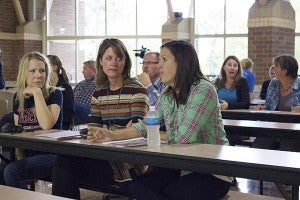
Including board members and administrators, about 100 people attended the first public hearing on the proposed calendar on Sept. 23 at Albert Lea High School. They broke into groups and discussed positives and negatives of the change. The results were then read to the school board. – Hannah Dillon/Albert Lea Tribune
2. School calendar splits district
In 2014, Albert Leans came to know just how vitally instrumental a school district’s calendar is to the daily lives of families, and a proposal to change the calendar divided the residents of Albert Lea Area Schools into three camps — for, against and undecided. It also brought more people to school board meetings than had been witnessed in the last decade.
On Dec. 1, the Albert Lea school board voted 3-3 on whether to submit a request to the state Department of Education for a waiver to the state law requiring classes to begin after Labor Day. That tie meant the same as defeat and would have been the end of a debate that had lasted for months, but then the board chairwoman, Linda Laurie, placed the matter on the meeting for Dec. 15. That didn’t get a quorum, so it came back again for a special meeting Dec. 29, where Laurie called for a motion but no board member complied.
The calendar went through various alterations, but in general it proposed to start school in August and have longer breaks during the year for the sake of remediation. The administration and school board were interested in reducing summer learning loss, especially among students in poverty. Superintendent Mike Funk noted that half of the district’s students were eligible for free or reduced lunches.
The issue of the calendar was the leading topic of debate during the school board election. On Election Day, incumbents Mark Ciota and Jill Marin retained their seats. Insurance broker Dave Klatt, who opposed the calendar plan, was elected to replace a seat being vacated by Jeshua Erickson. That meant after Jan. 1, the board would have four members opposed to the calendar proposal.
The school calendar issue had its origins in the board looking at ways for a few years to improve achievement. In April last year, Funk made a board presentation, and in March of this year, he shared details with district residents. Eventually, the district held three presentations on the issue, and it became clear that there were a growing number of opponents, many of whom were skeptical that changing the calendar by a handful of days would produce actual results but felt they couldn’t voice their views at the presentations.
The school board hired a firm to conduct a survey. Polling the first week of August, it found 62 percent in favor, 25 percent opposed and 13 percent undecided. Opponents soon picked the survey apart, particularly the information spoken to participants that opponents said made the survey a push poll. They also cried foul that August results do not reflect the community’s view by mid-October, as the opponents were getting people to change their views.
They also had wanted to hear from teachers, and the though the teachers’ union endorsed it, rumor had it that there were many teachers afraid to speak out.
About 100 people attended a board meeting on Nov. 17, and following a speech by Marin that brought new issues to consider, the board postponed the vote by two weeks. The school board granted an open microphone at that board meeting, and opponents spoke up. One teacher, Jo Ann Erickson, confirmed that many teachers were afraid to say anything for fear of reprisal.
The administration set up an online survey for teachers, but the link spread and the survey became invalid.
At the key Dec. 1 meeting, about 200 people showed up, and when the vote was over, the crowd erupted and gave a standing ovation. Funk said the community had made it clear not to “mess with our summer.”
3. Harshest winter in 35 years
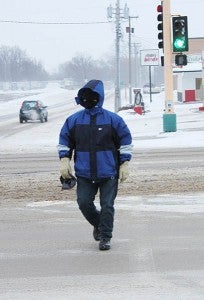
Joseph Madrigal crosses West Main Street at the First Avenue intersection Jan. 16, heading north. Covering the face made the difference when heading into the strong northwest wind. – Tim Engstrom/Albert Lea Tribune
Cold in Minnesota is news? It is when winter is the most unbearable it has been in 35 years. The first three months of 2014 were filled with news about blizzards, below-zero temps and blowing snow.
The year started Jan. 1 with 2 inches of snow falling in Albert Lea, adding to the 3 already on the ground from December, which had provided 8 1/2 inches falling from the sky.
A deep freeze settled over the Midwest that first weekend in January — that infamous polar vortex. Gov. Mark Dayton closed schools statewide. The temperature dropped to 20 below zero. Pipes burst in schools, businesses and homes. In fact, it became common last winter to walk into restrooms and see a faucet left running to keep pipes from breaking.
Old Man Winter continued to pound the next week with blowing snow that made white-knuckle driving conditions, giving Albert Lea the iciest roads in the state on Jan. 14. The day was filled with crashes on streets and freeways. Near-blizzard weather arrived Jan. 16, with sustained winds reaching 25 mph with gusts up to 41 mph and white-out conditions. Dozens of schools closed again.
Meanwhile, the propane market spiraled out of control thanks to a shortage, with prices shooting up to more than $5 a gallon. Customers were surprised to discover $700 bills.
A blizzard closed Interstate 90 most of Jan. 26, as 3 inches of snow fell on that cold Sunday. Travelers could stay at the Albert Lea Armory. Schools statewide closed. Southeast of Twin Lakes the wind speed was recorded at 52 mph. The freeway reopened the next morning. Two people had been hurt in a rollover on U.S. Highway 65 south of Glenville. A blanket of cold lingered over the Midwest that week, prompting schools to begin late or remain closed. It was 17 below in Albert Lea on the morning of Jan. 28.
More snow fell at other times that month, and on one day there were four people injured in highway crashes. The snow was 9 inches deep on Jan. 31. Albert Lea received 16 inches of snow in January, with 3 of them on the last day alone.
To top it all off, lake ice had become so deep — with so much snow on top, too — that fish were dying because of a lack of oxygen.
Mother Nature gave Albert Lea a brief respite from the wrath of winter in early February, with no snow and highs in the balmy teens. Then an inch and a third fell Feb. 9, and another half inch fell Feb. 12. Icy roads on Feb. 12 left one Geneva man dead in a crash near Blooming Prairie. Blowing snow and low visibility caused problems for motorists the afternoon and evening of Feb. 13, which prompted the Minnesota Department of Transportation to shut down I-35 between Geneva and Ellendale because of so many jackknifed semitrailers.
Four more inches of snow fell the weekend of The Big Freeze in mid-February and another inch soon after. But it was on Feb. 20 and 21 that Albert Lea received 9 inches of snow and strong winds. The power went out for thousands of places. I-35 was closed from Owatonna to the Iowa border and from Ames to Clear Lake.
Blowing snow continued to hinder travel that month. The Albert Lea school board added five more days to the calendar to make up for having so many snow days. All in all, Albert Lea received 16 inches of snow in February. The snow depth on the last day was 15 inches.
Residents on March 5 awoke to 8 inches of new snow, and thanks to snowfall on March 1 and 2, the snow depth reached its peak for the winter at 25 inches. The mercury on March 8 rose to 34 degrees — finally above freezing — and climbed March 10 to 43 and March 11 to 50, melting the white stuff. By March 15, the snow depth was at 2 inches. An inch and a half that fell March 19 and 20 didn’t accumulate. By the end of the month, winter was gone. March notched 12 inches of snow, and one day in April brought another 3 inches, meaning winter delivered 55 1/2 inches of snow to Albert Lea.
National Weather Service climatologists said the Midwest had experienced the coldest and most severe winter since 1979. The winter of 2014 will be remembered as the year the Arctic visited Minnesota.
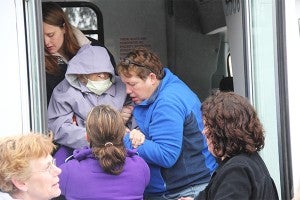
Alyssa Picht, behind, Donna Hovey, right, and Nicole Wahl, front, assist 100-year-old Margaret Godfrey down the steps of a bus the morning of Feb. 20 in Kensett. The women worked for Lutheran Retirement Home in Northwood, which had been evacuated because of an explosion at a fertilizer storage facility at the municipal airport. — Tim Engstrom/Albert Lea Tribune
4. Northwood evacuated
Northwood and Kensett are tied together in more ways than merely going to the same schools. When the 2,000 residents of Northwood had to be evacuated on Feb. 20 as a result of a suspected chemical fire ignited in a machine shed on the east side of the city, people were directed or driven six miles to the south to Kensett, population 261. There, authorities set up evacuation centers.
People with their own means of transportation stayed in hotels in Albert Lea, Mason City or Forest City or stayed with relatives.
Volunteers and authorities had set up a main evacuation center at the Kensett Community Center, and residents with pets were asked to go to Kensett City Hall.
People heard explosions and saw a fire that morning at the Northwood Ag Products at the airport off of Partridge Avenue. The company did have a fertilizer warehouse but the explosion and fire came from a shop where it stored tanker trucks with fertilizer as well as propane-powered forklifts. The propane tanks were cited as the source of the explosions. No one was in the shop at the time. Four were treated at Mercy Medical Center in Mason City.
According to Worth County Emergency Management Director Ray Huftalin, authorities had been concerned about exposure to sulphuric acid, but their fears shrank when they learned the fire came from the machine shed and not a fertilizer warehouse. The explosion occurred around 7:30 a.m. on a snowy but warm Thursday. The air temperature reached 42 degrees, but 7 inches of snow fell later that day, prompting Iowa transportation officials to close I-35 from Ames to Clear Lake.
The Worth County Sheriff’s Office said residents were allowed to return to their homes shortly after 3 p.m. after the U.S. Environmental Protection Agency had finished its testing and said the air was safe.
News of the small town’s evacuation made newspapers across the Midwest and even some around the nation. Even the CBS News website had a report posted at 3:34 p.m. that day. The Des Moines Register’s story was posted on USA Today that evening. It isn’t often an entire city is evacuated. Northwood received that distinction in 2014.
5. Pocket knife in locker stirs USC district
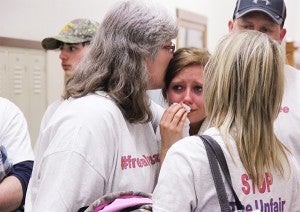
United South Central student Alyssa Drescher cries as she receives a hug from Wells resident Lisa Kibler after finding out she would be expelled for the rest of the school year.
– Sarah Stultz/Albert Lea Tribune
What a 17-year-old United South Central High School student described as an honest mistake became a topic of debate in April about whether zero-tolerance policies actually work.
Alyssa Drescher, then a junior, is now a senior who plays on the USC volleyball team. The school board unanimously expelled her April 24 after a 3 1/2-hour hearing and closed deliberations.
Drescher faced a 12-month expulsion after a drug dog smelled perfume in her locker and didn’t find drugs. However, police found a 3-inch pocket knife. She said it had been forgotten in her purse after cutting bales of hay at her boyfriend’s home a few days before.
Alyssa’s family and friends set up a Facebook page titled “We Support Alyssa Dee,” which has more than 6,700 likes. About 50 people gathered in front of the school in Wells on April 21 to show support for her and to influence the superintendent on the issue. Even Albert Lea gun store owner Milan Hart, then a candidate for representative in House District 27A, carried a Gadsen flag with the words “Don’t tread on me” and accused the school officials of acting like bullies.
Two dozen Republican state legislators signed a letter calling her a model student and urging Superintendent Jerry Jensen to find a “speedy and common sense solution.”
Alyssa’s father, Rick, argued that excessive punishment has not made a difference in the safety of students and does more to harm their futures, and Jensen said the knife presented a risk to the safety of all the students. The school’s policy prohibits the possession of weapons on school property. Jensen said though each case is different, the potential consequence for having a weapon on school property is expulsion of up to 12 months.
The expulsion the board handed down ultimately required the girl to leave the school for the remainder of the 2013-14 school year, but she was permitted to return in September, instead of a year later.
News stories prior to the expulsion were mainly local, but once the expulsion happened, then news outlets across Minnesota printed and aired stories about the decision. A Minneapolis Star Tribune piece explored whether a pocket knife is a weapon or a tool and whether zero-tolerance policies — a fad of the 1990s — protect or harm students.
In the end, Drescher said she has lost confidence in the adults responsible for her education for not seeing the incident as a simple teenage mistake.

Gov. Mark Dayton signs a bill June 13 at Edgewater Bay Pavilion for the state dedicating $7.5 million from the 2014 construction bill to the $15 million dredging of Fountain Lake. – Colleen Harrison/Albert Lea Tribune
6. Legislature OKs dredging
On May 20, Gov. Mark Dayton signed a bill into law authorizing $7.5 million in state funding to dredge Fountain Lake. The figure is half of the $15 million the Shell Rock River Watershed District had estimated as the cost to dredge the picturesque body of water in the center of Albert Lea.
The watershed district and the community had requested the funds for six years. It was in the 2014 session they were successful largely thanks to the assistance — and tenacious persistence — of state Rep. Shannon Savick, DFL-Wells. In addition to making connections at the Legislature, she reminded the DFL majority of how narrow their majority had been and how it relied on swing districts like House District 27A to vote in their favor. Ultimately, she still lost the election.
Watershed and city officials repeatedly said the dredging project is necessary because Fountain Lake has become filled with sediment — as much as 5 to 8 feet in some areas. The accumulation has resulted in water quality impairment and large algae blooms. The other half of the funding will come from a local-option half-cent sales tax.
The district in 2012 purchased a 51-foot Versi hydraulic dredge for $340,000, along with the pipes, pumping and other equipment necessary to pump the dredge material away from the lake for $435,000. It has also purchased land in the former Albert Lea Country Club that will be used as a staging area for the project and has contracted out for preliminary engineering.
Dayton visited Albert Lea in mid-June for a ceremonial signing of the bill. About 80 people came to see Dayton speak at Edgewater Bay Pavilion. Behind him stood 14 officials from Albert Lea, Freeborn County, Shell Rock River Watershed District, the Albert Lea Lakes Foundation and state government.
The ceremony was quick, and officials thanked Dayton for backing the project and roundly praised the community for its support during the legislative process.Albert Lea Lakes Foundation President Laura Lunde said the Lakes Foundation was founded in 1934 and noted the passage of funding was 80 years in the making for a lake in the heart of the city.
Lunde, in fact, received kudos for her role in pushing state officials to fund the dredging. She was named marshal of the Third of July Parade.
Albert Lea Mayor Vern Rasmussen reminded people of the importance of Fountain Lake to the community. He said Albert Lea is a city with a lake as its civic center and drew upon the city’s nickname.
The state funding for the lake cleanup came from a $1.1 billion construction bill that included many bonding-bill projects.
Questions arose in October when early estimates came in double and triple the $15 million figure. Watershed officials cautioned people to not be scared because those were based on different lakes with different strategies for sediment removal and said the $15 million is still on target.
7. Minimum wage goes up in Minnesota

Lyle Cafe owner Barbara Johnson of Winthrop speaks in support of a bill to raise Minnesota’s minimum wage during a news conference at the State Capitol in St. Paul. – Jim Mone/AP
The hourly wage in Minnesota on Aug. 1 climbed to $8 an hour, up from $6.15. The measure requiring the increase came out of the 2014 session of the state Legislature, and it gave raises to thousands of workers across the state who had been earning the federal minimum of $7.25 an hour. It was the first increase in minimum wage in Minnesota in nearly a decade.
In the stroke of Gov. Mark Dayton’s pen, Minnesota went from having one of the lowest minimum wages in the United States to being on track for having one of the highest. Dayton had fulfilled a campaign pledge.
What’s more, the new law mandates the minimum wage to go up to $9 on Aug. 1, 2015, and to $9.50 on Aug. 1, 2016. In 2018, minimum wage is slated to be indexed to rise as inflation rises.
There is a category for small employers, allowing for a minimum wage of $6.50 this year and $7.25 in 2015 and 2016 before being tied to the inflation index, and a category for employing workers under age 18, with similar wages as for small employers. Tip credit is not offered in Minnesota, and any tips must be in addition to the wage earned. Adding tip credit was discussed by legislators but left out of the bill.
While workers rejoiced, many employers locally and statewide voiced concerns about the challenge of finding the additional revenue, whether it came from saving on expenses, growing sales, increasing prices or possibly reducing staff. Smaller firms with tighter profits most likely will be the ones pinching pennies over the next three years, business experts said at the time.
On the other hand, Democrats argued that the increase would boost the spending power for poorer Minnesotans, which in turn would increase profits for merchants.
Economists said both sides have valid points and whether it is beneficial depends on the business.

A crowd of about 400 people attended the Albert Lea VA Clinic dedication April 26 at Skyline Plaza. – Colleen Harrison/Albert Lea Tribune
8. VA Clinic opens in Albert Lea
The news came in November 2013 from U.S. House Rep. Tim Walz — Albert Lea had been selected as the site for a new Veterans Affairs community-based outpatient clinic. It would go into the former JoAnn Fabrics location at Skyline Plaza. It would open in mid-2014.
It opened a little earlier than that. On April 26, about 400 people celebrated the opening of the VA Clinic in Albert Lea. About anyone in the region who could be considered a public official was present, and veterans from all over southern Minnesota and northern Iowa poured into the Skyline Plaza to hear from local and federal officials and to take tours of the clinic.
The opening came five years after the U.S. Department of Veterans Affairs announced it was seeking an outpatient clinic in south-central Minnesota. Albert Lea was one of a handful of communities being considered for the location, along with Austin and Owatonna. Local officials did all they could to accommodate, and Albert Lea’s proximity and ease of access to Iowa made the decision easier for VA officials. Because of the issue of wait times, northern Iowa veterans often prefer going to Minnesota clinics over Iowa ones.
The new VA Clinic was built and is operated by Louisville, Ky.-based company Valor Healthcare, which operates more than 30 other VA clinics in the country.
Scott Wise, chief operating officer with Valor, a subsidiary of Humana Government Business, said the clinic features highly trained staff who take their jobs seriously. He said the people who were hired to work at the clinic could have worked anywhere in the community but chose to work where they could take care of veterans.
Albert Lea Mayor Vern Rasmussen challenged local residents to make veterans feel welcome and comfortable in the community. He said he looks forward to making Albert Lea a second home for veterans from out of town.
After the ceremony, people in attendance walked outside Skyline Plaza to the entrance of the clinic, where there was a flag-raising ceremony and tours. Residents were also invited to attend a reception.
The clinic treats veterans for primary care, podiatry and mental health counseling. It has a dietitian, a social worker and a pharmacist on hand, along with tele-retinal and X-ray machinery. Patients can communicate with doctors at the Minneapolis VA Clinic through computer software.
9. City Council votes down reorganization
Albert Lea City Manager Chad Adams made a presentation in late September following two and a half years of considering ways to reorganize the city government to be more efficient and following a consultant recommendation. What Adams proposed on Sept. 25 included dissolving the Parks and Recreation Department into other departments and terminating the employment of the department’s director, 21-year employee Jay Hutchison.
The parks side would roll into the Public Works Department and the recreation side would be under the assistant city manager, Sack Thongavanh, in a department called administration. The city would seek to partner with other local agencies offering recreational services. Another department, the Albert Lea Public Library, would be under Thongavanh, too, as well as human resources and the city clerk. Adams sought to reduce the number of people who report to him from 10 down to seven, with only five departments: administration, police, fire, public works and legal. The city also would hire an assistant public works director.
Hutchison told the Tribune the next morning that he was devastated by the news.
Support for the plan seemed to lag as the weeks of October and November passed, as some residents wondered whether the city’s jewel of a parks system would lose priority in the long term. City employees were nervous and wondered who was next to go. Some raised concerns about Thongavanh residing in a Twin Cities suburb yet overseeing Albert Lea services. Others called the plan too administratively heavy.
City Councilor George Marin became the principal opponent, saying he was hearing from constituents that they didn’t favor the plan for various reasons, one being firing a parks director just to hire a civil engineer. He said he had concerns about the organizational chart and its lack of clear job descriptions. He proposed eliminating the assistant city manager’s position and an office specialist position.
The City Council voted 4-3 in favor of the reorganization at its Oct. 13 meeting, but it was only the first reading of the ordinance needed to enact the measure. The City Council on Oct. 28 voted to table the decision, and finally on Nov. 24 the council voted 5-2 to reject the proposed reorganization of the city government. Councilors said they had heard from dozens of people opposed to the plan. Former city workers came forward and said morale was the lowest they had seen in years.
Hutchison will remain the parks director and plans to stay in the position until retirement.
10. Refugees moving to Albert Lea

Pah Mu, in July, sits in a trailer used for Sunday worship services in the local Karen community. Her people, referred to as Karen, fled Burma to refugee camps in Thailand before making it to the U.S. – Colleen Harrison/Albert Lea Tribune
An estimated 350 refugees from South Sudan and Burma have moved to Albert Lea in the past 10 years, and their numbers are growing. About 250 of the 350 fled from Sudan to the United States because of the decades-long civil war, and about 100 people known as the Karen fled militaristic Burma and refugee camps in Thailand.
An additional 150 Karen people commute from St. Paul to Albert Lea each day for work at Albert Lea Select Foods.
The Albert Lea Tribune published a three-part series on refugees in Albert Lea last July.
While some of the refugees said they came to Albert Lea for work, others have come because of family or community connections. Running from danger for most of their lives, they said they are grateful for what the city offers as a safe and secure environment for themselves and their families — though it does have its challenges, like adjusting to another culture, learning English and figuring out government services such as laws for gaining a driver’s license or enrollment children in schools.
People were not used to living in a culture with structure, let alone electricity, appliances and other electronics. Many of them were in places with no schools and most lacked even the opportunity to read and write. They are grateful to reside in Albert Lea.
They can be found not only working in food processing but in more visible places, such as Walmart, U.S. Bank or Albert Lea High School.
Many of the refugees attend Adult Basic Education at Brookside Education Center to learn English and to work toward obtaining their GED.
Penny Jahnke, Adult Basic Education coordinator, said out of the 149 people who participated in the last school session, at least 75 percent — if not more — were refugees.
Jahnke said the people come to the school because they want to have jobs and want to be able to communicate with their neighbors and children, who are learning English in schools.
Growing up without things such as electricity, Sudanese refugee Dabang Gach said it is an adjustment to get used to things such as lights, stoves and other appliances.
Perhaps the largest challenge, however, is the challenge that comes from limited or sometimes the nonexistent ability to speak English.
Gach said many Sudanese refugees struggle to find jobs because of their limited ability to communicate.
Tha Htaw said it took him between five and seven times just to pass the written exam to obtain his driver’s license because he is not fluent in English.
Allyssa Sorenson, local Volunteers in Service to America coordinator, said she and others have been working to educate both the Karen and Sudanese communities on issues such as housing, transportation, law enforcement and even fishing regulations.
She said they hope to give more presentations in the future.
Ann Austin, executive director of the United Way of Freeborn County, said when refugees move to the United States it is not uncommon for them to first go to larger cities such as St. Paul, which are classified as resettlement communities with the federal government.
These cities promise to help refugees with various services, including housing, jobs, interpretation and education.
However, when refugees move away from larger resettlement communities to rural cities such as Albert Lea, they often find these resources are lacking.
Austin said while Albert Lea can offer jobs to refugees, it needs help offering the other resources.
Austin and a group of community members are trying to establish a resource center for refugees and other immigrants moving to Freeborn County.
A resource center would provide information on how to obtain a driver’s license or bank account, how to apply for jobs, where to go to find housing, where to find child care and and other guidelines, to name a few.

A portrait of Paul Sparks sits next to his remains during his memorial service in June at St. Theodore Catholic Church in Albert Lea. – Colleen Harrison/Albert Lea Tribune
Honorable mention for top stories
• Longtime Albert Lea City Manager Paul Sparks dies June 3 at age 69; hundreds attend his funeral
• Ellendale man Mark Misgen convicted Oct. 7 of burning down his own house to collect insurance fraudulently after a weeklong jury trial in Owatonna
• Blue Zones Project returns to Albert Lea; familiar infrastructure experts visit; more coming in 2015
• “Survivor” and “Interstellar” have Albert Lea ties; the former through the late soldier Corey Goodnature and the latter through specialty costumer Stacia Lang
• Albert Lea native, Melissa Roche, wins HGTV reality home makeover show “Brother vs. Brother” in summer months
• Nelson’s Marketplace announces plans to close May 17, then finds a buyer in Austin grocer Jim Baldus; supermarket reopens as MarketPlace Foods
• June rains flood streets and fields as 6 inches of rain falls in less than a week
• Tesla installs superchargers on north side of city to assist with cross-country travel in the company’s electric cars
• Murder trial for Northwood man slated for June in Fort Dodge, Iowa, postponed to October, then postponed to May 2015
• Bolshoi Ballet shown in high definition at Marion Ross Performing Arts Center
Top 25 Web stories
Here are the 25 most-clicked-on stories for albertleatribune.com for 2014, not including the final two weeks. Pageviews are from Google Analytics using its sample method. The listing shows day, date, headline, pageviews, writer and, when applicable, source of photograph:
1. Wednesday, May 28: 2 men die in wrong-way I-35 crash: 14,146 (Sarah Stultz)
2. Tuesday, Nov. 4: Watch this post for election results: 9,736 (Tim Engstrom)
3. Monday, Jan. 6: Hartland woman dies in I-35 crash: 9,319 (Sarah Stultz)
4. Tuesday, Aug. 12: Watch for election results here: 9,646 (Tim Engstrom)
5. Friday, April 18: Knife in locker spurs outcry at USC over school discipline: 9,111 (Sarah Stultz, with submitted photo)
6. Wednesday, June 18: Roof blown off house: 8,723 (Tim Engstrom and Sarah Stultz, with Sarah Stultz photo)
7. Saturday, Feb. 22: Road conditions still listed as hazardous: 8,580 (Staff Reports, Micah Bader photo)
8. Friday, Jan. 10: ‘Lone Survivor’ film has local tie: 8,033 (Tim Engstrom, movie art)
9. Friday, May 30: Motorcyclist injured in crash on County 46: 7,285 (Sarah Stultz, Sarah Stultz photo)
10. Monday, April 21: Residents come out to support USC student: 6,215 (Sarah Stultz, Colleen Harrison photos)
11. Friday, Sept. 12: County government mourns death of worker: 6,072 (Sarah Stultz)
12. Tuesday, April 8: Road caves in on Fifth Street; no one injured: 6,001 (Sarah Stultz, Sarah Stultz photo)
13. Friday, Aug. 8: Prostitution bust made: 5,906 (Sarah Stultz, 4 mugs)
14. Thursday, June 5: Freeborn woman injured in bizarre crash: 5,490 (Sarah Stultz, courtesy photo)
15. Tuesday, Oct. 21: Wells police officer is on leave: 5,407 (Sarah Stultz)
16. Friday, Jan. 31: Standoff near Lake Mills lasts 4 1/2 hours: 5,383 (Tim Engstrom, Tim Engstrom photo)
17. Wednesday, Sept. 17: Glenville man in critical condition after crash: 5,348 (Sarah Stultz)
18. Thursday, March 27: Police seize 10 dogs from Albert Lea home: 5,253 (Sarah Stultz)
19. Saturday, Aug. 16: A.L. liquor store robbed: 5,229 (Sarah Stultz)
20. Thursday, July 17: 1 injured in crash of motorcycle: 5,134 (Sarah Stultz)
21. Wednesday, Nov. 5: Deputy Freitag beats incumbent Kindler in vicious race: 4,789 (Sarah Stultz, Colleen Harrison photo)
22. Tuesday, June 3: Deputy running for sheriff placed on leave: 4,646 (Sarah Stultz, mug)
23. Friday, June 27: Albert Lea native still going on HGTV show: 4,551 (Sarah Stultz, submitted photo)
24. Monday, March 17: Businesses start in Albert Lea’s downtown: 4,504 (Sarah Stultz, Sarah Stultz photo)
25. Sunday, Jan. 26: 2 hurt in rollover south of Glenville: 4,409 (Brandi Hagen)
Top 5 Web obituaries
Here are the five most-clicked-on obituaries for albertleatribune.com for 2014, not including the final two weeks:
1. Tuesday, Jan. 28: Jessika Lokken, 30, Albert Lea: 6,928
2. Wednesday, April 9: Steven Brua, 1953-2014: 5,538
3. Friday, March 14: Tom Falk, 48, Maple Grove: 5,264
4. Friday, March 28: Kirk Aanes, 1964-2014: 4,932
5. Wednesday, June 25: Todd Johnson: 4,646




